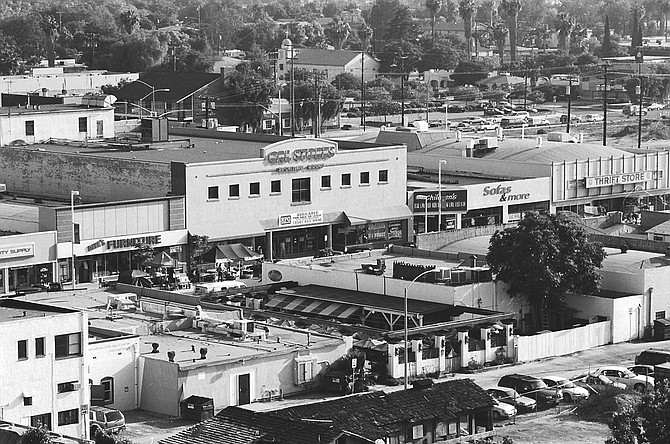 Facebook
Facebook
 X
X
 Instagram
Instagram
 TikTok
TikTok
 Youtube
Youtube

Innocence of the 1950s variety still draws me once in a while to the Grinder sandwich shop on the corner of Second and Greenfield in El Cajon. Afterward, to conjure up memories of my father’s sudden and unpredictable treats, I can drive across town for soft ice cream at one of the few Fosters Freezes remaining in San Diego County. And not long ago, after learning of the city’s downtown car shows on summer Wednesday evenings, I revisited the hot rods I chased as a teenager while cruising a small-town main drag.
But several blocks west of the Fosters Freeze on El Cajon Boulevard stands the regional headquarters of the Hells Angels, whose name for one of the hottest cities in the county is Hell Cajon. To the east, illusions of an idyllic time are further dispelled by the long stretch of Main Street, where the homeless and drug-addicted can be seen hanging out at most any time of day or night.
I learn that some good-willed business people have formed an association to rejuvenate the downtown area eastward from Main and Magnolia Avenue, El Cajon’s historic ground zero, which has begun to feature sidewalk-café-style dining. Its brand-new restaurants, however, have to share storefront space with an old hanger-on, F Street Books.
As squatters suddenly began appearing on ranches in Cajon Valley in the 1860s, so tent communities of homeless people are likely to pop up in various places in El Cajon today. One did recently behind the Gold Coast Apartments on Ballantyne Street. “I could look out the back door right now,” says its manager, “and see tents and sleeping bags and coffeepots on a grassy spot between my building and the courthouse.”
There seem to be 10,000 apartments in El Cajon; more than houses, anyway, says a resident who has lived in the community since the early ’50s. In the 1980s, city hall put a moratorium, still in effect, on building new apartment buildings. But low rents, relative to those in San Diego, have always been a magnet to the poor. Then some renters can’t pay their bills and end up on the streets.
What to do about the homeless is the dominant civic issue that divides Cajonians (well, it beats Cajones) these days. East County Republicanism seems torn between Christian values and property values. So some citizens favor a proposal to build a transitional-housing facility for the homeless at the Fabulous 7 Motel on East Main. But opponents have filed a lawsuit against it. One of their arguments is that the project will bring convicted felons into close proximity to the area’s children.
In front of the Grand Bar, back toward downtown El Cajon, a righteous drunk fumes to me about the transitional-housing project. Especially exercised about the hookers who may go there, he blurts out, “Why don’t they build them a whorehouse and get ’em off the street that way?”


Innocence of the 1950s variety still draws me once in a while to the Grinder sandwich shop on the corner of Second and Greenfield in El Cajon. Afterward, to conjure up memories of my father’s sudden and unpredictable treats, I can drive across town for soft ice cream at one of the few Fosters Freezes remaining in San Diego County. And not long ago, after learning of the city’s downtown car shows on summer Wednesday evenings, I revisited the hot rods I chased as a teenager while cruising a small-town main drag.
But several blocks west of the Fosters Freeze on El Cajon Boulevard stands the regional headquarters of the Hells Angels, whose name for one of the hottest cities in the county is Hell Cajon. To the east, illusions of an idyllic time are further dispelled by the long stretch of Main Street, where the homeless and drug-addicted can be seen hanging out at most any time of day or night.
I learn that some good-willed business people have formed an association to rejuvenate the downtown area eastward from Main and Magnolia Avenue, El Cajon’s historic ground zero, which has begun to feature sidewalk-café-style dining. Its brand-new restaurants, however, have to share storefront space with an old hanger-on, F Street Books.
As squatters suddenly began appearing on ranches in Cajon Valley in the 1860s, so tent communities of homeless people are likely to pop up in various places in El Cajon today. One did recently behind the Gold Coast Apartments on Ballantyne Street. “I could look out the back door right now,” says its manager, “and see tents and sleeping bags and coffeepots on a grassy spot between my building and the courthouse.”
There seem to be 10,000 apartments in El Cajon; more than houses, anyway, says a resident who has lived in the community since the early ’50s. In the 1980s, city hall put a moratorium, still in effect, on building new apartment buildings. But low rents, relative to those in San Diego, have always been a magnet to the poor. Then some renters can’t pay their bills and end up on the streets.
What to do about the homeless is the dominant civic issue that divides Cajonians (well, it beats Cajones) these days. East County Republicanism seems torn between Christian values and property values. So some citizens favor a proposal to build a transitional-housing facility for the homeless at the Fabulous 7 Motel on East Main. But opponents have filed a lawsuit against it. One of their arguments is that the project will bring convicted felons into close proximity to the area’s children.
In front of the Grand Bar, back toward downtown El Cajon, a righteous drunk fumes to me about the transitional-housing project. Especially exercised about the hookers who may go there, he blurts out, “Why don’t they build them a whorehouse and get ’em off the street that way?”
Comments